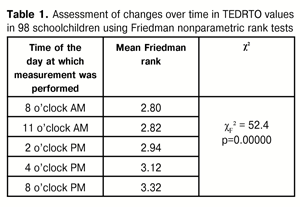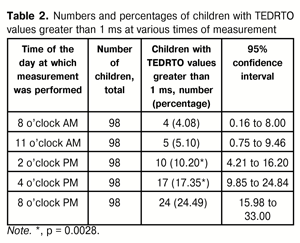|
https://doi.org/10.31288/oftalmolzh2016635
School-day biorhythms of threshold exposure duration for recognition of test objects in schoolchildren of grades 7 to 11
M.B. Zheliznik, Graduate Student
V.I. Serdiuchenko, Dr Sc (Med)
O.I. Dragomiretska, researcher
Filatov Institute of Eye Diseases and Tissue Therapy, NAMS of Ukraine
Odessa, Ukraine
E-mail: virais@ukr.net
Background: To the best of our knowledge, no study has yet reported on biorhythms of Threshold Exposure Duration for Recognition of Test Objects (TEDRTO).
Purpose: To investigate biorhythms of TEDRTO over a school day in children learning under intensive visual load conditions.
Materials and Methods: Ninety eight ophthalmologically healthy children (aged 13 to 17 years) attending a boarding school with advanced learning of a number of subjects underwent examination. A special electronic apparatus was used to present a test object (a Landolt’s ring having an angular size of 8 minutes of arc) to the child. Binocular TEDRTO measurements were performed at five time points during the day: at 8 o’clock AM, 11 o’clock AM, 2 o’clock PM, 4 o’clock PM, and 8 o’clock PM).
Results: Friedman's non-parametric test demonstrated that TEDRTO values gradually and statistically significantly increased (?? = 52.4; р=0.00000) during a school day. In addition, the number of children with TEDRTO values greater than 1 ms at various times of measurement gradually increased during a school day, and these children usually complained of increased visual fatigue.
Conclusions: There was a statistically significant worsening in TEDRTO values in schoolchildren learning over a day under intensive visual load conditions.
Key words: threshold exposure duration for recognition of test objects, schoolchildren, circadian biorhythms
Introduction
It is known that any function of the human body may depend on various time-related factors such as season of the year, day of the working week, time of the day at which the relevant examination is performed, etc [1-11]. Diurnal rhythms in body temperature, motional activity, respiration rate, physical and chemical properties of urine, and blood composition can be observed. Biorythmology is a science which deals with the effects of time-related factors on various body functions. The study of the biorythms of various body functions is considered to be of great importance in physiology of work, space medicine, and ocular ergonomics [1-4]. Studies have been reported on biorhythms of visual acuity, intraocular pressure, sensitivity to light and color, ocular convergence and lens accommodation (OCLA), and binocular vision [2, 5-8]. It has been proposed to take into consideration individual biorhythmic variations in visual acuity and OCLA when treating relevant disorders, namely, to use eye exercises during the acrophase (i.e., at the time of maximum of relevant characteristic), in order to improve the efficacy of treatment [6, 7].
However, to our knowledge, no study has reported on biological rhythms of Threshold Exposure Duration for Recognition of Test Objects (TEDRTO).
The study purpose was to investigate biological rhythms of TEDRTO in children attending a school with advanced learning of a number of subjects and thus having a rather long school day.
Materials and Methods
Ninety eight schoolchildren with visual acuity of not worse than 1.0, refraction within the normal range for the child's age and aged 13 to 17 years were included into the study. The children attend a boarding school with advanced learning of a number of subjects (chemistry with biology, physics with mathematics, or foreign languages). Every school day they have 7 lessons; in addition, they have self-preparation sessions from 16 to 19. The ophthalmological examination included visual acuity, refraction (or skiascopy), ocular motility, and examination of the media and fundus. In addition, Threshold Exposure Duration for Recognition of Test Objects was assessed with a special electronic apparatus. The apparatus makes it possible to expose a test object (an illuminated Landolt’s ring with a gap randomly at one of the eight positions) against a black background, with the test object presented for several milliseconds, and 1-ms gaps between presentations. The TEDRTO assessment procedure has been reported previously in detail [12]. In each schoolchild, the TEDRTO values were assessed five times a school day: at 8 o’clock AM (before classes), 11 o’clock AM, 2 o’clock PM (after classes), 4 o’clock PM (before self-preparation sessions), and 8 o’clock PM (after self-preparation sessions). The data was obtained for monocular and binocular presentation of test objects.
The Friedman's non-parametric test was used for statistical analysis of changes in TEDRTO values over time. Post hoc analysis with Wilcoxon signed-rank tests was conducted with a Bonferroni correction applied for multiple comparisons. For the analysis of an increase in the number of children showing signs of fatigue with the measurements made from 8 o’clock in the morning to 8 o’clock in the morning, 95% confidence intervals for percentages were calculated. Statistical tests with a p-value < 0.05 were considered significant. Statistical analyses were performed using Statistica 10.0 from StatSoft (Tulsa, Oklahoma, USA).
Results
The analysis of the data obtained for the whole sample (98 schoolchildren aged 13 to 17 years) was performed, since previously we have demonstrated [12] that TEDRTO values for the groups of children aged 11-14 years were practically the same as those for 15-17 years.
Table 1 presents the results of the assessment of changes over time in binocular TEDRTO values using Friedman nonparametric rank tests. The table demonstrates that TEDRTO values gradually and statistically significantly increased, with an increase in mean rank from 2.80 at 8 AM to 3.32 at 8 PM (?F? = 52.4; р = 0.00000). Paired comparisons demonstrated a statistically significant increase in TEDRTO values at 2 o’clock PM compared to those at 8 o’clock AM (р = 0.0028 with a Bonferroni correction applied for multiple comparisons).


Table 2 presents the numbers and percentages of children with TEDRTO values greater than 1 ms. The table shows that the number of children with TEDRTO values greater than 1 ms gradually increased during the day (р < 0.05 for the comparisons of the measurements between examinations 3 and 2 and between examinations 4 and 3).
It is noteworthy that children with TEDRTO values greater than 1 ms usually complained of increased visual fatigue. These children were advised on the mode of visual load most suitable and on doing special eye exercises on a regular basis.
Our study findings are in line with previous reports demonstrating the effect of visual load associated with learning process on the major visual functions [3, 8].
Conclusions
We found insubstantial although statistically significant changes in threshold exposure duration for recognition of test objects (TEDRTO) values in school children over a school day under conditions of increased visual load. Given a continual increase in the amount of computerization in schools, colleges and universities, as well as wide use of various gadgets even by pre-school children, the development and/or selection of the most informative techniques for the assessment of the effect of intensive visual load on the major visual functions is still deemed to be important. The findings show the need for further research in the relevant area.
References
1. Aschoff J, editor. Biological Rhythms. New York: Plenum; 1981
Crossref
2. Kovalenko VV. [Biological rhythms in visual function]. Oftalmol Zh. 1981; 5:297-300 Russian
3. Moiseeva NI, Sysuev VM. [Time medium and biological rhythms]. Leningrad: Nauka; 1981 Russian
4. Teterina TP. [Binocular rivalry in diagnosis and treatment of fatigue]. In: [Proceedings of the International Symposium on Ocular Ergonomics Outcomes and Prospects: Moscow, Russia, February 13-15, 1991] Russian
5. Volkova LP. [Periodicity of visual perception events in a binocular visual act and some aspects of using this phenomenon] [Abstract of Cand Sc (Med) Thesis]. St Petersburg; 1991. 20 p. Russian
6. Drozdov OG. [Status of ocular convergence and lens accommodation and treatment of its disorders in mildly myopic children]. [Abstract of Cand Sc (Med) Thesis]. Odessa: Filatov Institute of Eye Disease; 1991. 16 p. Russian
7. Klopots’ka NG. [Efficacy of treatment of various types of amblyopia based on the circadian rhythms of the visual system]. [Abstract of Cand Sc (Med) Thesis]. Odessa: Filatov Institute of Eye Disease; 2003. 19 p. Ukrainian
8. Pavlichenko NA, Serdiuchenko VI, Danilenko NI. [Biological rhythms in absolute accommodation and visual performance of school children during a school day and school week]. Oftalmol Zh. 1999; 3:174-8 Russian
9. Klerman EB, Gershengorn HB, Duffy F, Kronauer, RE. Comparisons of the variability of three markers of the human circadian pacemaker. J Biol Rhythms. 2002 Apr;17(2):181-93
Crossref Pubmed
10. Kelly G. Body temperature variability (part 1): a review of the history of body temperature and its variability due to site selection, biological rhythms, fitness, and aging. Altern Med Rev. 2006;11: 278-93
11. Kr?uchi K, Wirz-Justice A. Circadian rhythm of heat production, heart rate, and skin and core temperature under unmasking conditions in men. Am J Physiol. 1994 Sep;267(3 Pt 2):R819-29
Crossref Pubmed
12. Serdiuchenko VI, Zheliznik MB. [Age-related changes in children’s threshold exposure duration for recognition of test objects]. Oftalmol Zh. 2016; 5:41-3 Ukrainian
Crossref
|


